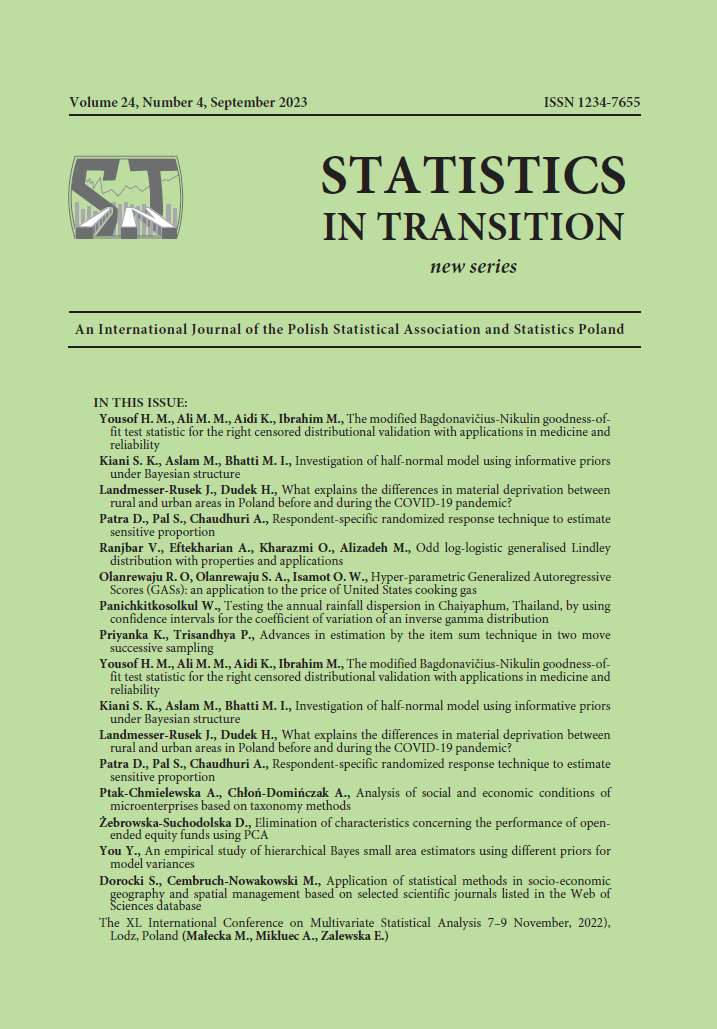© Sania Khawar Kiani, Muhammad Aslam, M. Ishaq Bhatti. Article available under the CC BY-SA 4.0 licence
![]()
ARTICLE
ABSTRACT
This paper considers properties of half-normal distribution using informative priors under the Bayesian criterion. It employs the squared root inverted gamma, Chi-square and Rayleigh distributions as the prior distribution to construct the Posterior distributions of the respective distributional parameters. Hyperparameters are elicited via prior predictive distribution. The properties of posterior distribution are studied, and their graphs are presented using a real data set. A comprehensive simulation scheme is conducted using informative priors. Bayes estimates are obtained using the loss functions (squared error loss function, modified loss function, quadratic loss function and Degroot loss function). Statistical inferences interval estimates and Bayesian hypothesis testing are presented to demonstrate the usefulness of the study.
KEYWORDS
informative prior, squared root inverted gamma distribution (SRIG), Bayesian hypothesis testing, loss functions.
REFERENCES
Al Amer, F. M., Thompson, C. G. and Lin, L., (2021). Bayesian methods for meta-analyses of binary outcomes: implementations, examples, and impact of priors. International journal of environmental research and public health, 18(7), p. 3492.
Ayman and Kristen, (2013). On the gamma-half normal distribution and its applications. Journal of Modern Applied Statistical Methods, 12(1), p.15.
Allan, A. T., Hill, R. A., (2021). Definition and interpretation effects: how different vigilance definitions can produce varied results. Animal Behaviour, 180, pp.197–208.
Ariyo, O., Lesaffre, E., Verbeke, G. and Quintero, A., (2022). Model selection for Bayesian linear mixed models with longitudinal data: sensitivity to the choice of priors. Communications in statistics-simulation and computation, 51(4), pp. 1591–1615.
Aslam, M., (2003). An Application of the Prior Predictive Distribution to Elicit the Prior Density. Journal of Statistical Theory and Applications, 2(1), pp. 70-83.
Aslam M., Saleem, M., (2009). On Bayesian Analysis of the Rayleigh Survival Time Assuming the Random Censor Time. Pakistan Journal of Statistics, 25(2), pp. 71–82.
Berger, O. J., (1985). Statistical Decision Theory and Bayesian Analysis. 2nd edition, Springer Series in Statistics, ISBN–10: 0-387-96098-8 and –13: 978-0387-96098-2.
Bland, J. M., Altman, D., G., (1999). Measuring agreement in method comparison studies. Stat Methods Med Res 8, pp. 135–160.
Bruch, C., Felderer, B., (2022). Prior Choice for the Variance Parameter in the Multilevel Regression and Post stratification Approach for Highly Selective Data. A Monte Carlo Simulation Study. Austrian Journal of Statistics, 51(4), pp. 76–95.
Casella, L., Elberly, G., (2003). Estimating Bayesian Credible Intervals. Journal of the Statistical Planning and Inference, 112, pp. 115–32.
Cohen, A. C., (1991). Truncated and censored samples: theory and applications. CRC press.
Cordeiro, G. M., Pescim, R. R. and Ortega, E. M., (2012). The Kumaraswamy generalized half-normal distribution for skewed positive data. Journal of Data Science, 10(2), pp. 195–224.
Cooray, K., Ananda, M. M. A., (2008). A generalization of the half-normal distribution with applications to lifetime data. Communication in Statistics – Theory and Methods, 37, pp. 1323–1337.
Dobler, C., (2015). Stein's method for the half-normal distribution with applications to limit theorems related to the simple symmetric random walk. ALEA: Latin American Journal of Probability and Mathematical Statistics, 20(109), p. 34.
Jeffreys, H., (1998). The theory of probability. OUP Oxford.
Martin, O. A., Kumar, R. and Lao, J., (2022). Bayesian Modeling and Computation in Python. Chapman and Hall/CRC.
Moravveji, B., Khodadadi, Z. and Maleki, M. A., (2019). Bayesian Analysis of Two-Piece Distributions Based on the Scale Mixtures of Normal Family. Iran J Sci Technol Trans Sci., 43, pp. 991–1001.
Patra, L. K., Kumar, S. and Gupta, N., (2018). Estimation of the Location Parameter of a General Half-Normal Distribution. International Conference on Mathematics and Computing Springer, Singapore, pp. 281–293.
Pewsey, A., (2002). Large-sample inference for the general half-normal distribution. Communications in Statistics-Theory and Methods, 31(7), pp. 1045–1054.
Pewsey, A., (2004). Improved likelihood based inference for the general half-normal distribution. Communications in Statistics-Theory and Methods, 33(2), pp.197–204.
Robert, C. P., Casella, G., (1994). Distance weighted losses for testing and confidence set evaluation. Test, 3(1), pp. 163–182.
Saleem, M., Raza, A., (2011). On Bayesian Analysis of the Exponential Survival Time Assuming the Exponential Censor time. Pakistan Journal of Science, 63(1).
Provost, S. B., Mabrouk, I., (2010). A generalized exponential-type distribution. Pak. J. Statist, 26(1), pp. 97–110.
Shrivastava, A., Chaturvedi, A. and Bhatti, M. I., (2019). Robust Bayesian analysis of a multivariate dynamic model. Physica A: Statistical Mechanics and its Applications, 528, p. 121451.
Sindhu, T. N., Hussain, Z., (2022). Predictive Inference and Parameter Estimation from the Half-Normal Distribution for the Left Censored Data. Annals of Data Science, 9(2), pp. 285–299.
Silvia, M., Vanessa, O. and Argiento, R., (2020). Bayesian isotonic logistic regression via constrained splines: an application to estimating the serve advantage in professional tennis.
Sanchez, J. J. D., da Luz Freitas, W. W. and Cordeiro, G. M., (2016). The extended generalized half-normal distribution. Brazilian Journal of Probability and Statistics, pp. 366–384.
Van Erp, S., Browne, W. J., (2021). Bayesian Multilevel Structural Equation Modeling: An Investigation into Robust Prior Distributions for the Doubly Latent Categorical Model. Structural Equation Modeling: A Multidisciplinary Journal, 28(6), pp. 875–893.
